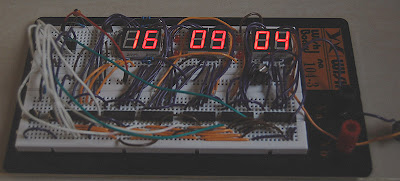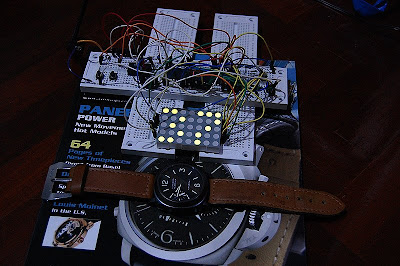8x8 Led Dot Matrix Clock using PIC16F627A
7-Segment PIC Digital Clock : The photographs
The prototype of the 7-Segment PIC Digital Clock. Check out 7-Segment Digital Clock for the schematic and source code.








Setting Internal Oscillator for PIC16F627A
I love to use PIC16F627A and PIC16F628 because they come with internal oscillators. That means I can make a project with lower component count (without 1 crystal and 2 load capacitors). The project setting of MikroC for using internal oscillator of the PIC16F627A shows below:


DS1307 + PIC16F877A
DS1307 is a popular Real Time Clock (RTC) chip from MAXIM . Now, PIC16F877A is my favorite microcontroller. So, I was looking for information about interfacing DS1307 with PIC16F877A but I found only information in assembly language (assembly is not my cup of tea) and other C compilers. I use only mikroC. I adapted what I have found from the Internet. The source code is listed below:
//Sample code for
//DS1307 RTC Ineterfacing with PIC16F877A
//Coded by Pynn Pynn
//Compiler: mikroC 8.0.0
//http://picnote.blogspot.com
//07/06/2008
//Use with your own risk
unsigned short read_ds1307(unsigned short address );
unsigned short sec;
unsigned short minute;
unsigned short hour;
unsigned short day;
unsigned short date;
unsigned short month;
unsigned short year;
unsigned short data;
char time[9];
char ddate[11];
unsigned char BCD2UpperCh(unsigned char bcd);
unsigned char BCD2LowerCh(unsigned char bcd);
void main(){
I2C_Init(100000); //DS1307 I2C is running at 100KHzPORTB = 0;
TRISB = 0; // Configure PORTB as output
TRISC = 0xFF;
Lcd_Init(&PORTB); // Initialize LCD connected to PORTBLcd_Cmd(Lcd_CLEAR); // Clear displayLcd_Cmd(Lcd_CURSOR_OFF); // Turn cursor offLcd_Out(1, 1, "TIME:");
Lcd_Out(2, 1, "DATE:");
while(1)
{
sec=read_ds1307(0); // read secondminute=read_ds1307(1); // read minutehour=read_ds1307(2); // read hourday=read_ds1307(3); // read daydate=read_ds1307(4); // read datemonth=read_ds1307(5); // read monthyear=read_ds1307(6); // read year
time[0] = BCD2UpperCh(hour);
time[1] = BCD2LowerCh(hour);
time[2] = ':';
time[3] = BCD2UpperCh(minute);
time[4] = BCD2LowerCh(minute);
time[5] = ':';
time[6] = BCD2UpperCh(sec);
time[7] = BCD2LowerCh(sec);
time[8] = '\0';
ddate[0] = BCD2UpperCh(date);
ddate[1] = BCD2LowerCh(date);
ddate[2] ='/';
ddate[3] = BCD2UpperCh(month);
ddate[4] = BCD2LowerCh(month);
ddate[5] ='/';
ddate[6] = '2';
ddate[7] = '0';
ddate[8] = BCD2UpperCh(year);
ddate[9] = BCD2LowerCh(year);
ddate[10] = '\0';
Lcd_Out(1,6,time);
Lcd_Out(2,6,ddate);
Delay_ms(500);
}
}
unsigned short read_ds1307(unsigned short address)
{
I2C_Start();
I2C_Wr(0xd0); //address 0x68 followed by direction bit (0 for write, 1 for read) 0x68 followed by 0 --> 0xD0I2C_Wr(address);
I2C_Repeated_Start();
I2C_Wr(0xd1); //0x68 followed by 1 --> 0xD1
data=I2C_Rd(0);
I2C_Stop();
return(data);
}
unsigned char BCD2UpperCh(unsigned char bcd)
{
return ((bcd >> 4) + '0');
}
unsigned char BCD2LowerCh(unsigned char bcd)
{
return ((bcd & 0x0F) + '0');
}
As I don't have DS1307 in hand, so I test my code with Proteus ISIS simulator. The image shows the working clock. Click on the image for big image.

//Sample code for
//DS1307 RTC Ineterfacing with PIC16F877A
//Coded by Pynn Pynn
//Compiler: mikroC 8.0.0
//http://picnote.blogspot.com
//07/06/2008
//Use with your own risk
unsigned short read_ds1307(unsigned short address );
unsigned short sec;
unsigned short minute;
unsigned short hour;
unsigned short day;
unsigned short date;
unsigned short month;
unsigned short year;
unsigned short data;
char time[9];
char ddate[11];
unsigned char BCD2UpperCh(unsigned char bcd);
unsigned char BCD2LowerCh(unsigned char bcd);
void main(){
I2C_Init(100000); //DS1307 I2C is running at 100KHzPORTB = 0;
TRISB = 0; // Configure PORTB as output
TRISC = 0xFF;
Lcd_Init(&PORTB); // Initialize LCD connected to PORTBLcd_Cmd(Lcd_CLEAR); // Clear displayLcd_Cmd(Lcd_CURSOR_OFF); // Turn cursor offLcd_Out(1, 1, "TIME:");
Lcd_Out(2, 1, "DATE:");
while(1)
{
sec=read_ds1307(0); // read secondminute=read_ds1307(1); // read minutehour=read_ds1307(2); // read hourday=read_ds1307(3); // read daydate=read_ds1307(4); // read datemonth=read_ds1307(5); // read monthyear=read_ds1307(6); // read year
time[0] = BCD2UpperCh(hour);
time[1] = BCD2LowerCh(hour);
time[2] = ':';
time[3] = BCD2UpperCh(minute);
time[4] = BCD2LowerCh(minute);
time[5] = ':';
time[6] = BCD2UpperCh(sec);
time[7] = BCD2LowerCh(sec);
time[8] = '\0';
ddate[0] = BCD2UpperCh(date);
ddate[1] = BCD2LowerCh(date);
ddate[2] ='/';
ddate[3] = BCD2UpperCh(month);
ddate[4] = BCD2LowerCh(month);
ddate[5] ='/';
ddate[6] = '2';
ddate[7] = '0';
ddate[8] = BCD2UpperCh(year);
ddate[9] = BCD2LowerCh(year);
ddate[10] = '\0';
Lcd_Out(1,6,time);
Lcd_Out(2,6,ddate);
Delay_ms(500);
}
}
unsigned short read_ds1307(unsigned short address)
{
I2C_Start();
I2C_Wr(0xd0); //address 0x68 followed by direction bit (0 for write, 1 for read) 0x68 followed by 0 --> 0xD0I2C_Wr(address);
I2C_Repeated_Start();
I2C_Wr(0xd1); //0x68 followed by 1 --> 0xD1
data=I2C_Rd(0);
I2C_Stop();
return(data);
}
unsigned char BCD2UpperCh(unsigned char bcd)
{
return ((bcd >> 4) + '0');
}
unsigned char BCD2LowerCh(unsigned char bcd)
{
return ((bcd & 0x0F) + '0');
}
As I don't have DS1307 in hand, so I test my code with Proteus ISIS simulator. The image shows the working clock. Click on the image for big image.

Big 5x7 Led Dot Matrix Clock with new font
Now, I'm so crazy about led dot matrix clocks and led dot matrix watches. Just recently, I have upgraded my small 5x7 Led Dot Matrix Clock with a bigger green 5x7 led dot matrix display and a new font.
For the images below, the time 21:44:37 was displaying on the clock. The clock display is big comparing to a 44mm Panerai (PAM 4).



The code for the new font is showing below:
For the images below, the time 21:44:37 was displaying on the clock. The clock display is big comparing to a 44mm Panerai (PAM 4).



The code for the new font is showing below:
const unsigned char char2[][4]={
{0x0E,0x11,0x0E,0x00}, //0{0x09,0x1F,0x01,0x00}, //1{0x13,0x15,0x09,0x00}, //2{0x11,0x15,0x0A,0x00}, //3{0x1C,0x04,0x0F,0x00}, //4{0x19,0x15,0x12,0x00}, //5{0x0E,0x15,0x12,0x00}, //6{0x13,0x14,0x18,0x00}, //7{0x0A,0x15,0x0A,0x00}, //8{0x09,0x15,0x0E,0x00}, //9{0x0A,0x04,0x0A,0x00}, //Comma1{0x04,0x0A,0x04,0x00} //Comma2};
{0x0E,0x11,0x0E,0x00}, //0{0x09,0x1F,0x01,0x00}, //1{0x13,0x15,0x09,0x00}, //2{0x11,0x15,0x0A,0x00}, //3{0x1C,0x04,0x0F,0x00}, //4{0x19,0x15,0x12,0x00}, //5{0x0E,0x15,0x12,0x00}, //6{0x13,0x14,0x18,0x00}, //7{0x0A,0x15,0x0A,0x00}, //8{0x09,0x15,0x0E,0x00}, //9{0x0A,0x04,0x0A,0x00}, //Comma1{0x04,0x0A,0x04,0x00} //Comma2};

